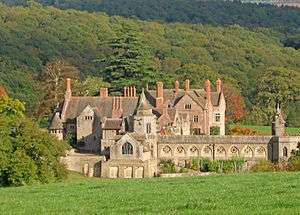Dinmore Manor

Dinmore Manor House is a large rural house in a well-wooded, hilly part of Herefordshire in the least populous parish of the county, Dinmore. It was substantially rebuilt in late 16th century, altered around 1830 and extended around the year 1928. The main house is a Grade II listed building. The outlying chapel is mostly medieval and is grade II* listed.
Ownership and rare public access
The 19,167 square feet (1,780.7 m2) Manor is owned by former Carphone Warehouse Director Martin Dawes. As of April 2018 the entire 1500 acre estate is up for sale for an undisclosed amount. In addition to the Manor House, the wider estate includes 21 other residential properties, a magnificent shoot, an outstanding cattle breeding facility and a world class equestrian complex[1]. The Estate is currently closed to the public apart from occasional shoot days [2]. The Estate also has a successful cattle breeding operation which specialises in pedigree Limousin cattle[3]
Garden and woodland
At 165 metres (541 ft) above sea level, centred two-thirds up a many-miles long stepped east slope, the site has viewpoints over the abrupt north-south vale of the Lugg to the Malvern Hills. The garden has a 1,200-year-old Yew. The compact formal garden is not listed. It mainly comprises a rock garden, a group of Acers and a water garden.
Chapel
The chapel to Saint John of Jerusalem remains on the site. Erected in the early part of the 12th century and formerly attached to the Commandery, it was rebuilt in 1370 in the Norman and Decorated architectural styles. A rectangular building, it consists of a chancel, a nave, a north porch and a western tower with spire. It was thoroughly restored in 1886 by Rev. Harris Fleming St John MA, chaplain (1878–1903), and filled with painted windows executed by himself. Stated to have had the privilege of sanctuary, it sits 50 people.[4] It is grade II* listed.[5]
Rooms
The building was developed from 1189 by the Knights Templar. The house (excluding its narrow rear extension) was mostly rebuilt in late 16th century, altered around 1830 and extended around the year 1928. The main house is a Grade II listed building[6]
The house's music room is a hall projection with a vaulted ceiling and a Victorian Aeolian Pipe Organ. It is separately listed in a group with the cloisters which adjoin it.[7]
The house overlooks the garden and lawn, and cloisters flank it to the right. The back wall of the cloisters features stained glass windows; coloured light streams onto the columns most late afternoons.[8]
In 1950 British Railways named a new GWR 7800 'Manor' Class steam locomotive, No.7820, after the manor. It is now preserved and operates on the Gloucestershire Warwickshire Railway.
Racehorses
Dawes has turned the modest pasture and arable fields into a racehorse stud and training ground, and retained much of its woodland. For this including the cost of the horses he may have spent around £14 million.[9]
| Wikimedia Commons has media related to Dinmore Manor. |
References
- ↑ https://www.onthemarket.com/details/4738364/
- ↑ http://www.shootinguk.co.uk/shooting/shoot-reports/high-game-shooting-in-herefordshire-12793
- ↑ http://www.dinmore.net/about.html
- ↑ "Dinmore Manor". Kelly's Directory of Herefordshire. 1913. Retrieved 2009-09-25.
- ↑ Historic England. "Details from listed building database (1348966)". National Heritage List for England.
- ↑ Historic England. "Details from listed building database (1099393)". National Heritage List for England.
- ↑ Historic England. "Details from listed building database (1348927)". National Heritage List for England.
- ↑ http://www.heritage-images.com/Preview/PreviewPage.aspx?id=1646910&licenseType=RM&from=search&back=1646910
- ↑ Kay, Richard (2008-10-03). "£1m battle of Charles' pal". Daily Mail. London. Retrieved 2009-09-25.